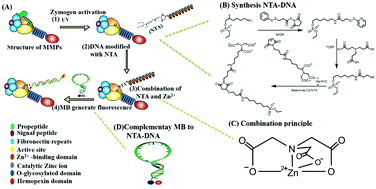A DNA-directed covalent conjugation fluorescence probe for in vitro detection of functional matrix metalloproteinases†
Abstract
Matrix metalloproteinases (MMPs) have been considered to contribute to the progression of tumorigenesis and tumor invasion; MMP-9 in particular, has been regarded as a priority target in cancer treatment due to its massive up-regulation in malignant tissues and its ability to degrade type IV collagen. In this work, we employed a DNA-directed covalent conjugation method to design a fluorescence probe for in vitro detection of functional matrix metalloproteinases, by which a nitrilotriacetic acid (NTA)-modified DNA probe can combine with the Zn2+ in the active site of MMPs, and then a molecule beacon (MB) modified FITC and BHQ1 can open to bond with their complementary base, NTA-modified DNA. We can evaluate the amount of MMPs in the medium according to the fluorescence intensity. The detection procedure can be finished in 30 min with good selectivity, cheap reagents and easy preparation. All the results and the amount of secreted MMPs under three different cell culture conditions are in accordance with previous reports. Satisfactory results are obtained. Furthermore, owing to the importance of MMP-9, we designed an approach to achieve the desired selectivity and specificity of our work, using dual amplification for improving fluorescence intensity based on RCA to detect the amount of MMP-9.



 Please wait while we load your content...
Please wait while we load your content...